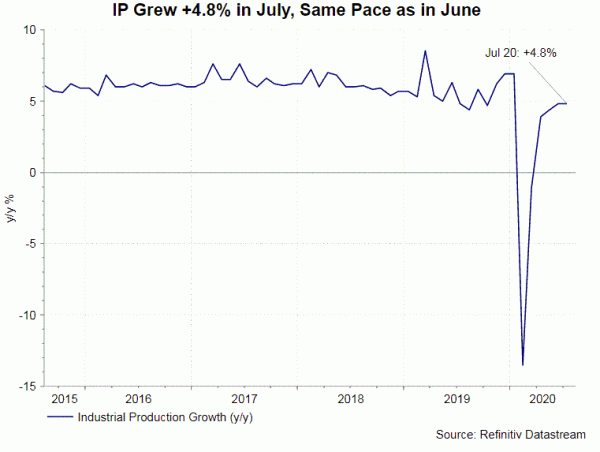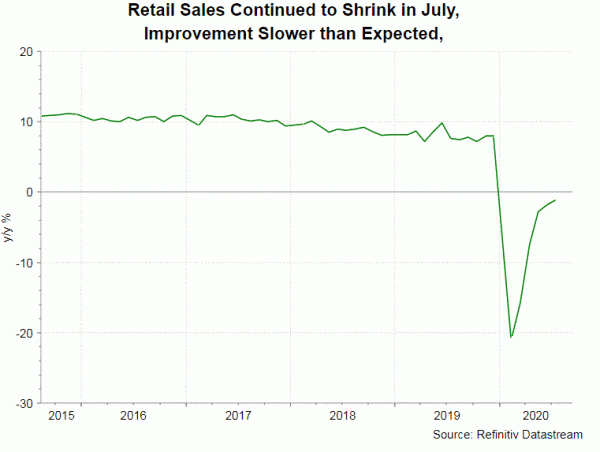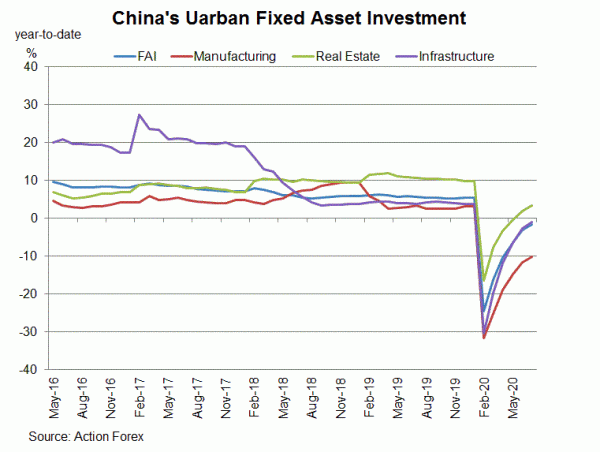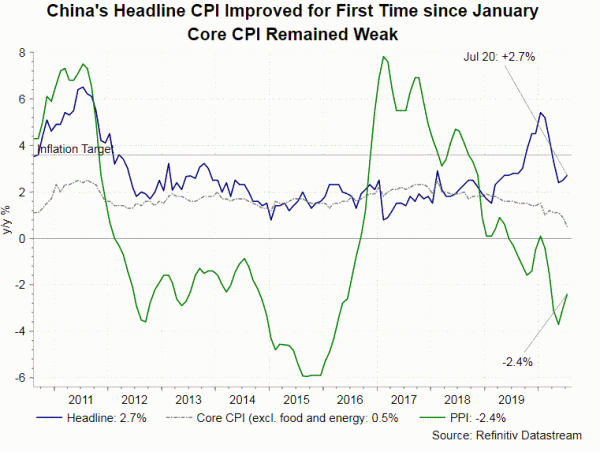The latest set of macroeconomic data suggests that the pace of recovery in China remained slow, as a result of flooding and second wave of coronavirus outbreak. Improvement industrial activities decelerated, while retail sales continued to shrink. Weak domestic spending was evident in subdued core CPI released earlier this week. The government should maintain an easing bias in the monetary policy, while the measures will be more targeted.
Industrial production (IP) grew +4.8% y/y in July, same pace as in June but missed consensus of +5.2%. Retail sales dropped -1.1% yoy, missing consensus of a +0.1% though better than June’s -1.8% contraction. Retail sales have been in contraction since the beginning of the year. Although July’s decline marked another month of improvement, the pace was slower than expected.

 Urban fixed asset investment (FAI) dropped -1.6% y/y in the first 7 months of the year, in line with expectations. For the month of July, FAI rose +6.1% y/y after a +4.1% increase in June. Led by the government, infrastructure investments jumped +11.4% y/y last month, up from +7.2%in June. Real estate investment growth also accelerated to +11.6% y/y in July from +8.4% a month ago. Manufacturing investment contracted -3.2% y/y in July, narrowing from -5.3% in the prior month.
Urban fixed asset investment (FAI) dropped -1.6% y/y in the first 7 months of the year, in line with expectations. For the month of July, FAI rose +6.1% y/y after a +4.1% increase in June. Led by the government, infrastructure investments jumped +11.4% y/y last month, up from +7.2%in June. Real estate investment growth also accelerated to +11.6% y/y in July from +8.4% a month ago. Manufacturing investment contracted -3.2% y/y in July, narrowing from -5.3% in the prior month.
Released earlier this week, headline CPI inflation climbed +0.2 percentage point to 2.7% y/y in July. Food price growth accelerated to +13.2% y/y in July from +11.1% a month ago, mainly driven to fresh vegetables and pork prices. Specifically, fresh vegetables price rose +7.9% yoy in July, accelerating from +4.2% in June due to regional flooding. Pork price soared +85.7% y/y in July, after a +81.6% gain in June. Non-food CPI (excluding food only) eased to a flat reading (0% y/y) in July from +0.3% a month ago. Core CPI (excluding food and energy) slowed to +0.5% y/y from June’s +0.9%. Fuel cost inflation contracted -15.5% y/y in July, after a decline of -19.1% in the previous month. Upstream inflation showed signs of improvement, PPI deflation narrowed to -2.4% y/y in July from -3% a month ago.
Improvement in headline CPI was mainly driven by food inflation, rather than strong underlying growth momentum. Core CPI remained weak, suggesting that domestic consumption has remained weak. This is consistent further decline in retail sales. Since food inflation has been driven by temporary factors, e,g, flooding, headline CPI will likely moderate in coming months.













